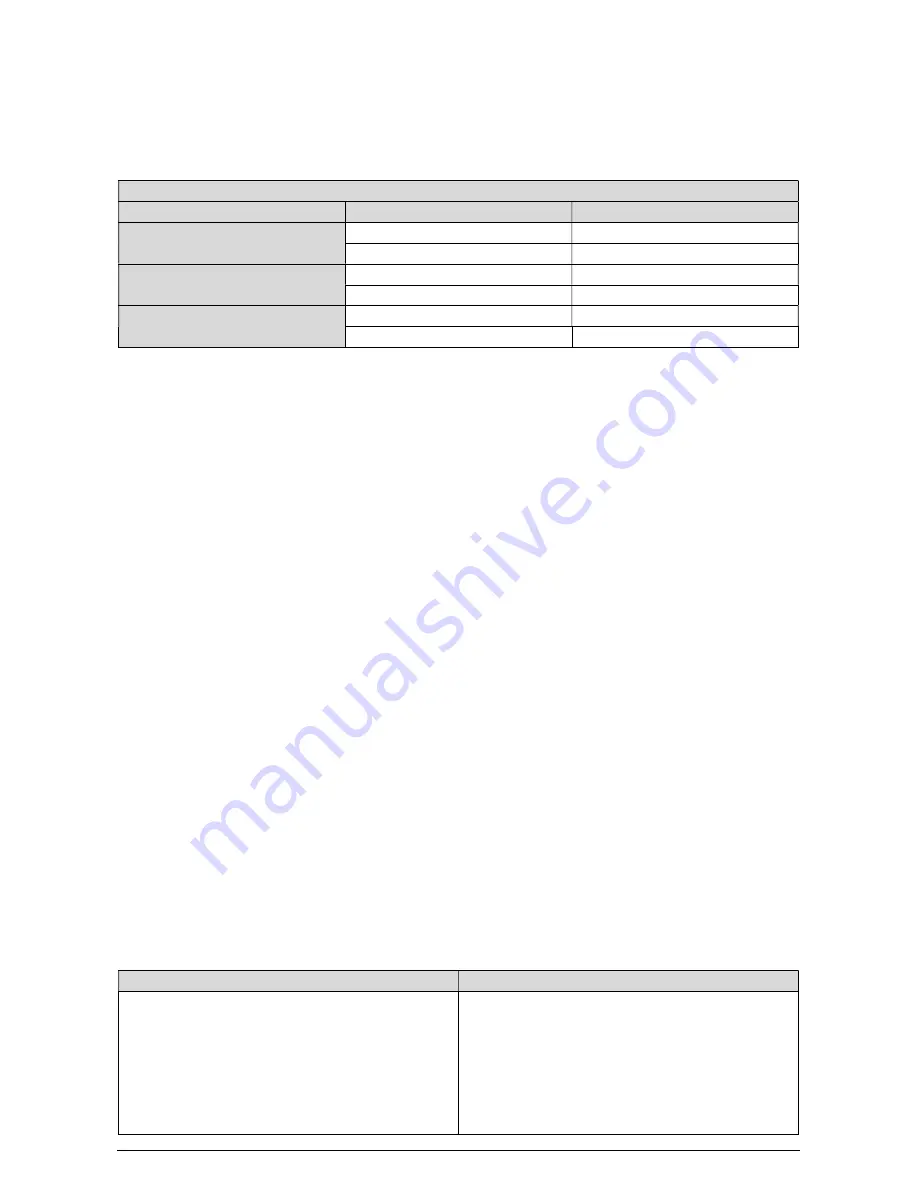
5.2
DIGITAL INPUT
LogBox BLE
has a digital input channel that can be configured for
"Pulse Count", "Event Log", or even for "Logs Control". This digital input can be
disabled.
Regardless of the function for which it will be used, the sensor output type that will be connected to the input must be configured: PNP, NPN, or Dry
Contact (refer to chapter INSTALLATION to see how the s
ensors should be connected). In addition to that, you must select which digital signal
edge of interest to ge
nerate the count, event or start/end of logs for: rising edge, falling edge, or both edges.
Relationship between Sensor Type
, Sensor Status, and Logical Level obtained in LogBox BLE
Sensor Type
PNP
NPN
Dr
y Contact
Sensor State
Open
Closed
Open
Closed
Open
Closed
Table 03
- Digital Input
Logical Level
0
1
1
0
1
0
For Dry Contact sens
ors, it is necessary to set a debounce time of at least 50 ms (sensor stabilization time - time in which the sensor must remain
in the state of interest for it to be considered valid). However, for PNP or NPN type sensors, it is not necessary to set a debounce time if
they are
configured for "Pulse Count". However, if the digital input is configured for "Event Log" or "Logs Control", a minimum debounce of 50 ms is required
to prevent any noise from generating a false event. In the "Event Log
" and "Logs Control" modes, events will be generated after the end of the
debounce time.
5.2.1 PULSE COUNT
When setting the digit
al input in "Pulse Count" mode, you can select an application mode: "Flow Rate" or "Count".
The "Flow Rate" mod
e allows, if "Average Flow by Acquisition Interval" is selected, to log the average flow rate or, if "Volume since Last Reset" is
selected, to count the total volume within a previously configured period until the count is reset.
The "Count" mode, in turn, allows, if the "Acquisition Interv
al Counting" option is selected, to count the number of pulses that occurred within the
Log Interval or, if the "Accumulated Count since Last Reset", to count the total number of pulses logged within a preset period until the count is
reset.
LogBox BLE
has a 32-bit register, responsible for accumulating the volume or number of pulses within a certain configurable reset interval. For
example, you can set the device to reset on a monthly basis or on a specific day and time (See ACCUMULATOR RESETTING MODES section of
the C
ONFIGURATION SOFTWARES chapter).
LogBox BLE
also h
as a 16-bit register, responsible for measuring the average flow rate per acquisition interval or for performing the count per
a
cquisition interval. At each log interval,
LogBox BLE
cou
nts the number of pulses that have occurred and registers it in memory, resetting the
register so that it can
accumulate the pulses of the next interval.
If the sensor is a Dry Contact type, the
LogBox BLE
count registers (16 bits and 32 bits) will be able to count up to 10 pulses per second. For PNP
and NPN sensors, 2
000 pulses per second. However, in the case of the 16-bit register, it is important to note that these pulses will accumulate
wi
thin each logging interval. Thus, if the "Average Flow through Acquisition Interval" or "Acquisition Interval Count" modes are selected, it is
necessary to evaluate the maximum sensor frequency so that it does not exceed 65535 counts (16 bits) within the logging interval, ca
using an
overflow in the logger that accumulates them.
If the maximum sens
or frequency is 2 kHz,
LogBox BLE
will accumulate 2000 pulses per second for up to 32 seconds. Upon excee
ding this
interval, the number of accumulated pulses will exceed 655
35 counts, resulting in overflow in the 16-bit register. For a sensor that can reach 2000
pulses per second, the recommended log frequency should
be less than 32 seconds.
When the option "Vol
ume since last reset" or the option "Accumulated count since last reset" is selected, the number of counts is, in turn, limited by
the 32-bit accumulator register and, thus, enables the counting of a limit number of 4294967295 pulses. Thus, the periodicity of the reset
must also
be adjusted according to the frequency of the sensor pulses. By keeping the same example of sensor use at maximum frequency, i.e. 2
kHz, it is
recommended that th
e periodicity be less than 24 days, otherwise an overflow will be generated in the register.
In typical applications, such as flow and volume measureme
nt, simple pulse counting is not enough, being necessary to convert these pulses into a
flow unit. For this, one can select the desired flow unit and
a conversion factor that transforms the number of pulses generated by the connected
transmitter in flow information. The pulse conversion logged in the interval for the flow unit configured by the user will occur every time th
e logged
data is displayed.
To streamline the co
nfiguration of the digital channel in "Pulse Count" mode and the conversion to flow in the unit required for the user,
LogBox
BLE
provides the following units of measure:
Flow Units
l/s,
l/min,
l/h,
gal/s,
gal/min,
gal/h,
m³/s,
m³/min,
Sensor Units
pulses/l,
pulses/gal,
pulses/m³.
15/65










































